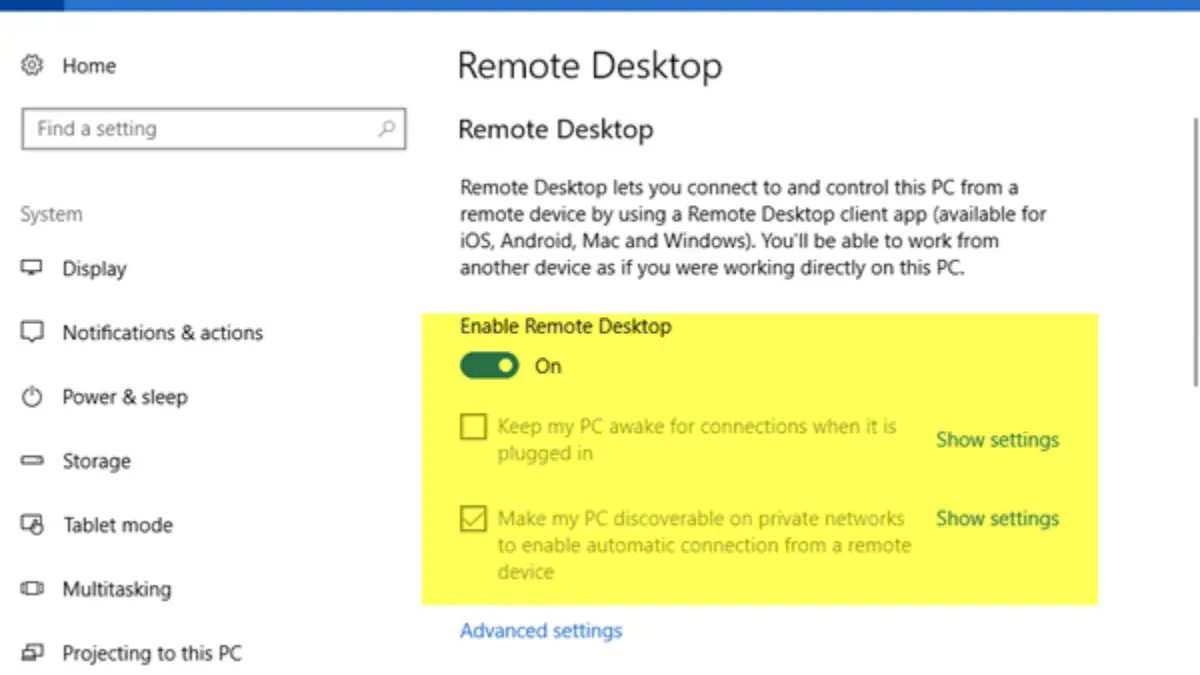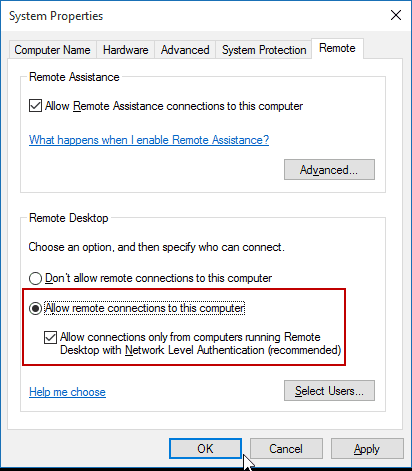Applies to: Configuration Manager (current branch)
This procedure describes configuring the default client settings for remote control. These settings apply to all computers in your hierarchy. If you want these settings to apply to only some computers, assign a custom device client setting to a collection that contains those computers. For more information a see How to configure client settings.
Nov 19, 2020 Enable Remote Desktop on Windows 10 Press Win+X then select Settings to open Windows Settings. Select the System option. In the list on the left side of the Windows Settings window, select the Remote Desktop option. Starting with Windows 10 build 20161, you will need to open Settings instead, click/tap on the System icon, and click/tap on About on the left side. 2 Click/tap on the Remote settings link on the left side of the System window. (see screenshot below). You can configure your PC for remote access with a few easy steps. On the device you want to connect to, select Start and then click the Settings icon on the left. Select the System group followed by the Remote Desktop item. Use the slider to enable Remote Desktop. Enabling Remote Desktop. First, we need to enable Remote Desktop and select which users have remote access to the computer. Hit Windows key + R to bring up a Run prompt, and type “sysdm.cpl.” Another way to get to the same menu is to type “This PC” in your Start menu, right click “This PC” and go to Properties.
To use Remote Assistance or Remote Desktop, it must be installed and configured on the computer that runs the Configuration Manager console. For more information about how to install and configure Remote Assistance or Remote Desktop, see your Windows documentation.
Use Windows Server 2019 for your Remote Desktop infrastructure (the Web Access, Gateway, Connection Broker, and license server). Windows Server 2019 is backward-compatible with these components, which means a Windows Server 2016 or Windows Server 2012 R2 RD Session Host can connect to a 2019 RD Connection Broker, but not the other way around.
To enable remote control and configure client settings

In the Configuration Manager console, choose Administration > Client Settings > Default Client Settings.
On the Home tab, in the Properties group, choose Properties.
In the Default dialog box, choose Remote Tools.
Configure the remote control, Remote Assistance and Remote Desktop client settings. For a list of remote tools client settings that you can configure, see Remote Tools.
You can change the company name that appears in the ConfigMgr Remote Control dialog box by configuring a value for Organization name displayed in Software Center in the Computer Agent client settings.
Client computers are configured with these settings the next time they download client policy. To initiate policy retrieval for a single client, see How to manage clients.

Enable keyboard translation
By default, Configuration Manager transmits the key position from the viewer's location to the sharer's location. This can present a problem for keyboard configurations that differ from viewer to sharer. For example, a viewer with an English keyboard would type an 'A', but the sharer's French keyboard would provide a 'Q'. You now have the option of configuring remote control so that the character itself is transmitted from the viewer's keyboard to the sharer, and what the viewer intends to type arrives at the sharer.
To turn on keyboard translation, in Configuration Manager Remote Control, choose Action,and choose Enable keyboard translation to transmit key position.
Note
Special keys, such as ~!#@$%, will not be translated correctly.
Keyboard shortcuts for the remote control viewer
| Keyboard shortcut | Description |
|---|---|
| Alt+Page Up | Switches between running programs from left to right. |
| Alt+Page Down | Switches between running programs from right to left. |
| Alt+Insert | Cycles through running programs in the order that they were opened. |
| Alt+Home | Displays the Start menu. |
| Ctrl+Alt+End | Displays the Windows Security dialog box (Ctrl+Alt+Del). |
| Alt+Delete | Displays the Windows menu. |
| Ctrl+Alt+Minus Sign (on the numeric keypad) | Copies the active window of the local computer to the remote computer Clipboard. |
| Ctrl+Alt+Plus Sign (on the numeric keypad) | Copies the entire local computer's window area to the remote computer Clipboard. |
We’ve all been there – we’ve finished at a customer’s site, and need to quickly remote in later on to finish/fix something. Trouble is, Windows doesn’t enable Remote Desktop Protocol by default.
There are four steps needed to remotely enable RDP connections in Windows 10.
Setup Remote Desktop Windows 10 Outside Network
- Open ports in the Windows firewall
- Edit the registry
- Start the Remote Desktop service
- Connect
This guide relies on you being on the same LAN as the remote PC you wish to access – you may already have RDP’ed into another server on that LAN. You must also have Windows administrative privileges for the remote computer. These instructions work well in a domain environment.
Note: If you have access to the computer, you can follow the standard procedure for enabling Remote Desktop.
Step 1: Open firewall ports in Windows firewall
There is no native way to change the settings of a remote Windows firewall. However, you can use PsExec from SysInternals to disable it or change some rules.
If you download the app and drop it into your c: drive, you can run this command and get command line access for that remote box.
c:psexec remote_machine_name cmd
Once you have that command line open, you can run this command to disable the firewall:
netsh advfirewall set currentprofile state off
Alternatively you can run this command to allow only Remote Desktop while still leaving the rest of the firewall as is:
netsh advfirewall firewall set rule group=”remote desktop” new enable=Yes
Step 2: Registry Changes to enable Remote Desktop
Chrome Remote Desktop Windows 10

Option 1: Psexec registry changes
While still in psexec, run this command to change the remote registry:
reg add “HKEY_LOCAL_MACHINESYSTEMCurrentControlSetControlTerminal Server” /v fDenyTSConnections /t REG_DWORD /d 0 /f
Option 2: Manually change registry settings
If you don’t want to continue using psexec, you can follow these instructions instead.
Load up the Services MMC (Control Panel > Administrative Tools > Services), right click on “Services (Local)” and choose “Connect to another computer”. Enter the name of your remote machine and connect to it. You should now be able to find the “Remote Registry” service and start it.
Depending on your environment, this may already be running, but I have found it generally isn’t on newly imaged computers.
It’s time to make use of the Remote Registry and actually enable RDP. Load up regedit and go to File > Connect Network Registry. Enter the name of your remote computer and connect to it. Navigate to HKEY_LOCAL_MACHINE > System > CurrentControlSet > Control > Terminal Server. Change the value of “fDenyTSConnections” to “0”.
Step 3: Start the Remote Desktop service
Go back to the Services MMC you used in Step 2 Option 2, find the service “Remote Desktop Services” and start it (or restart if it is already running).
Step 4: Connect
By this point you should be able to connect to a remote desktop session on your remote computer. Remember that only administrative users can connect to an out-of-the-box Remote Desktop setup.
If you have got this far and still can’t connect, it is worth checking your firewall rules to ensure nothing is being blocked.
